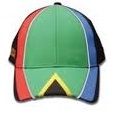 |
| With a tap, click or swipe across the screen children can access embedded videos, high quality photographs, maps, animations and pop-up boxes. |
 |
Maramedia has adapted its printed manuals into colourful fully interactive digital manuals for tablet devices. (Images: Wilma den Hartigh)
|
Maramedia Publishing's interactive digital manuals are a first for South Africa and are changing the way children experience education.
The Johannesburg-based publishing company has until now produced printed manuals for children and teachers. The manuals, which comply with the Department of Basic Education's curriculum policy statement, are a combination of textbooks, study guides and workbooks to supplement learning in the classroom.
In keeping with modern technological trends, Maramedia has adapted their manuals into colourful fully interactive digital manuals (IDMs) for tablet devices.
Advancing education
Former South African president Nelson Mandela was once quoted saying that "education is the most powerful weapon you can use to change the world", and Maramedia's digital offering introduces a new way to address Madiba's wish for all South Africans to receive a good education.
Speaking at the launch event at Liliesleaf Farm in Rivonia on Nelson Mandela International Day, Maramedia CEO Gideon van Niekerk said the interactive and multimedia component of the IDM devices has become an essential learning tool. "The devices inspire pupils to be more adventurous in their work, bringing learning to life," van Niekerk says.
Browsing a digital manual is visually similar to turning the pages of a book, but because these books are digital children use taps, clicks or swipes across the screen to access embedded videos, high quality photographs, maps, animations and pop-up boxes. Unlike traditional textbooks, the manuals have been designed in full colour, which helps children to retain more information.
Maramedia's digital content has also received the stamp of approval of Google SA's new media specialist, Brett St Clair. "The Maramedia content is one of the most advanced rich media experiences I have seen on smart devices," St Clair said. "At Google we are incredibly excited about this type of content."
Going digital and changing education trends
Maramedia's director of research and development, Deon Kotzé, said although printed material continues to be an important learning tool, children of today need an active learning environment.
Today's children are constantly engaging with social media such as Twitter, Facebook and instant messaging, and bringing modern technology into the classroom can only enhance learning.
"It can inspire children to become lifelong learners and not just be passive recipients of knowledge," Kotzé says.
The layout is highly visual and every topic has review questions at the end of each section to test pupils' level of understanding. Class activities and worksheets are also included. The facts are brought to life with photo galleries, animated diagrams and pop-up boxes with additional information on just about every page. "Research shows that real comprehension takes place through visual representation and interaction with content," explains Kotzé. "If you don't engage pupils and make them participants, you lose them."
Van Niekerk says introducing technology into education is important. "In the past 20 years, the education sector in South Africa has seen the least improvement and advancement compared to other sectors such as mining, banking or industry," he says.
The nuts and bolts
The content of the digital manuals can be downloaded on Android- and Apple-enabled tablets, or obtained on pre-loaded external memory cards.
A major benefit is that the IDM doesn't require internet or WiFi access to view the content.
"Not everyone has internet access," van Niekerk says, but despite this offline functionality, many users can still access the Internet to explore beyond what is covered in class by doing additional searches for information.
One of the perceived drawbacks of the new initiative is the cost of tablets, but according to Maramedia, even the most well-known tablet brands have become more affordable of late.
Another option is for teachers to use the tablets to project content onto whiteboards or smart boards in the classroom, while children use printed workbooks.
This is one way for resource-poor schools to benefit from the new technology, as the digital content is similar to that of printed manuals, and could also prove to be more cost effective than printed books. Pupils will have fewer books to carry, too.
The content is current and tackles issues such as renewable energy, global warming and the tsunami in Japan – everything that pupils would have heard about in the news. The content has been compiled from many sources and is constantly updated in keeping with curriculum changes.
Benefits for teachers
The manuals aren't just about making learning fun for children. The interactive component offers teachers many explanations, animations and 3D graphics to explain abstract concepts.
This means teachers can spend more time teaching as they no longer have to spend hours trawling through many different resources to add to their lesson plans.
"They will have more time to devote to engaging with their pupils, moulding their knowledge and focusing on personal interaction," Kotzé said at the launch.
By: Wilma den Hartigh
What do you think?
With low cost tablets such as the $20 tablets (view post), E-manuals as supplied by Maramedian, could change the way we perceive education in South Africa. After viewing Maramedia Publishing's price list of 2012 the difference between printed and digital average around R560 and R660.Thus purchasing a tablet at a low cost could work out the same as purchasing the printed material without the benefits of a tablet. This is surely something to consider?




